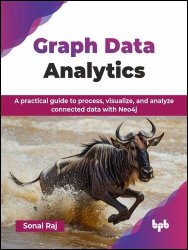 Название: Graph Data Analytics: A practical guide to process, visualize, and analyze connected data with Neo4j Название: Graph Data Analytics: A practical guide to process, visualize, and analyze connected data with Neo4j
Автор: Sonal Raj
Издательство: BPB Publications
Год: 2025
Страниц: 372
Язык: английский
Формат: epub (true)
Размер: 15.8 MB
For most modern-day data, graph data models are proving to be advantageous since they facilitate a diverse range of data analyses. This has spiked the interest and usage of graph databases, especially Neo4j. We study Neo4j and cypher along with various plugins that augment database capabilities in terms of data types or facilitate applications in Data Science and Machine Learning using plugins like Graph Data Science (GDS).
A significant portion of the book is focused on discussing the structure and usage of graph algorithms. Readers will gain insights into well-known algorithms like shortest path, PageRank, or Label Propagation among others, and how one can apply these algorithms in real-world scenarios within a Neo4j graph.
Once readers become acquainted with the various algorithms applicable to graph analysis, we transition to Data Science problems. Here, we explore how a graph's structure and algorithms can enhance predictive modeling, prediction of connections in the graph, etc. In conclusion, we demonstrate that beyond its prowess in data analysis, Neo4j can be tweaked in a production setup to handle large data sets and queries at scale, allowing more complex and sophisticated analyses to come to life.
As part of the NoSQL family, graph databases store data as entities (nodes) and their relationships (edges) rather than in rows and columns. This structure makes them ideal for managing complex, interconnected data, such as social networks, recommendation systems, and fraud detection. In a graph database, data relationships are as important as the data itself, allowing easy visualization of connections between items, which is useful for analyzing user profiles, social links, and recommendations.
Unlike traditional databases that rely on rigid schemas, graph databases offer scalability, intuitive data representation, and efficient querying. Their structure, based on interconnected nodes, enables faster and more flexible data retrieval, making it easy to uncover patterns and make data-driven decisions with lower computational resources. These features are particularly beneficial for applications requiring real-time insights, as graph databases avoid the slow, resource-heavy table traversals seen in traditional databases.
Key Features:
- Utilizing graphs to improve search and recommendations on graph data models.
- Understand GDS and Neo4j graph algorithms including cluster detection, link prediction, and centrality.
- Complex problem-solving for predicting connections, application in ML pipelines and GNNs using graphs.
What you will learn:
- Understand Neo4j graphs and how to effectively query them with cypher.
- Learn to employ graphs for effective search and recommendations around graph data.
- Work with graph algorithms to solve problems like finding paths, centrality metrics, and detection of communities and clusters.
- Explore Neo4j’s GDS library through practical examples.
- Integrate machine learning with Neo4j graphs, covering data prep, feature extraction, and model training.
Who this book is for:
The book is intended to serve as a reference for data scientists, business analysts, graph enthusiasts, and database developers and administrators who work or intend to work on extracting critical insights from graph-based data stores.
Contents:
1. Data Representation as Graphs – Introducing Neo4j
2. Processing Graphs with Cypher Queries
3. A Peek into Recommendation Engines and Knowledge Graphs
4. Effective Graph Traversal and the GDS Library
5. Centrality Metrics, PageRank, and Fraud Detection
6. Understanding Similarity and Cluster Analysis Algorithms
7. Applications of Graphs to Machine Learning
8. Link Prediction with Neo4j
9. Embedding, Neural Nets, and LLMs with Graphs
10. Profiling, Optimizing, and running Neo4j and GDS in Production
Скачать Graph Data Analytics: A practical guide to process, visualize, and analyze connected data with Neo4j
|